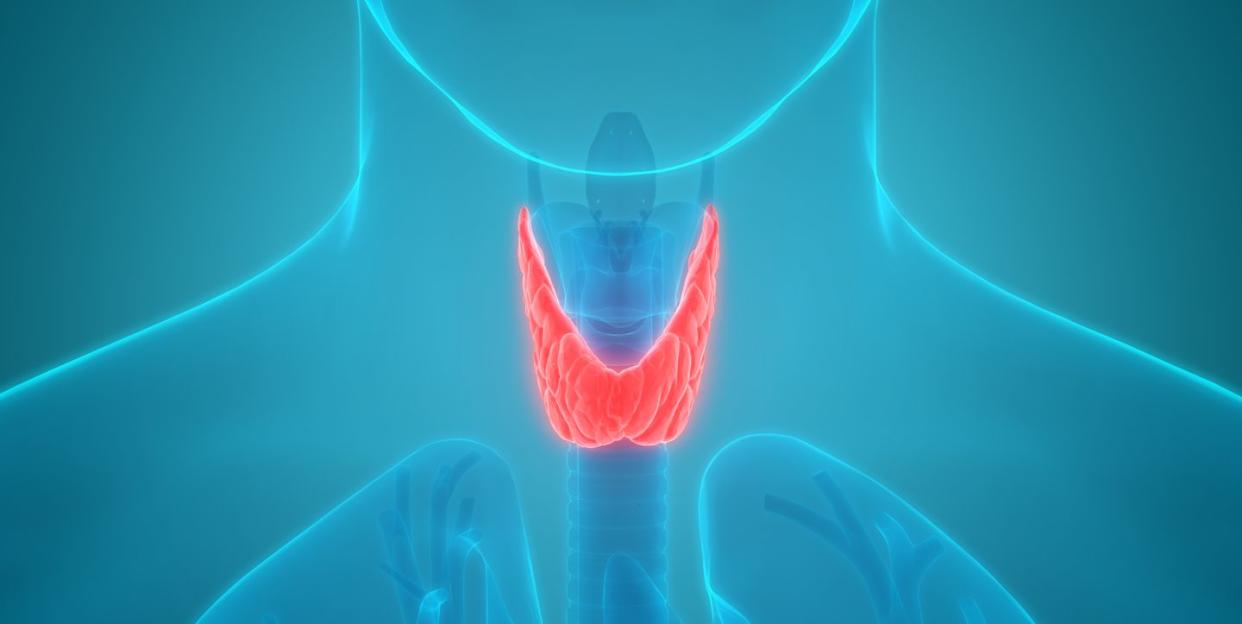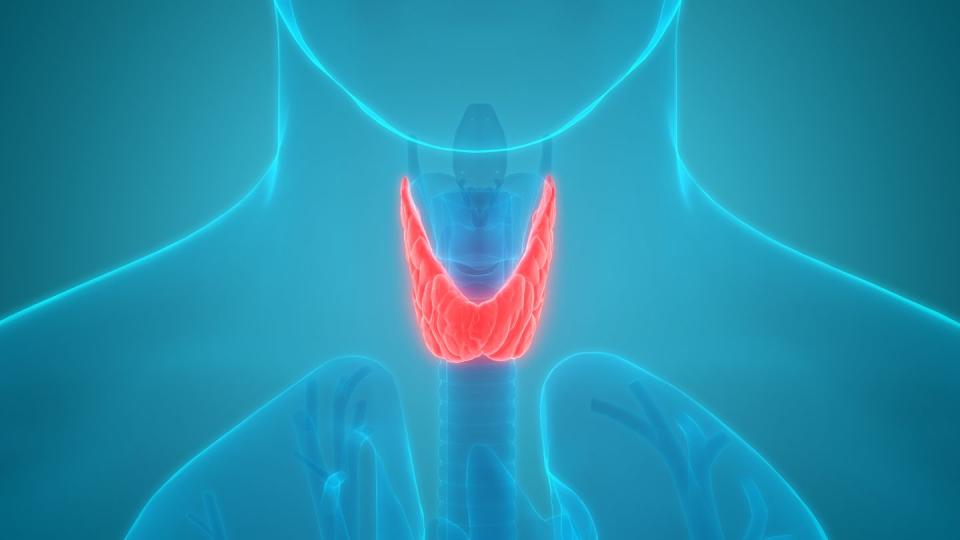How to Spot the Symptoms of Thyroid Cancer, the Fastest Growing Cancer in the U.S.

As women, we know getting screened for cancer is important. Every year, we schedule our mammograms to check for breast cancer, and we sync up with our dermatologists to make sure we don’t have any troublesome moles. But there’s one cancer on the rise in women that we might not be paying quite as much attention to: thyroid cancer.
“Thyroid cancer is an abnormal growth of thyroid cells that has the potential to spread to other parts of the body,” says Kyle Zanocco, MD, an endocrine surgeon and assistant professor of surgery at UCLA Health. Thyroid cancer occurs when thyroid cells—which make up the butterfly-shaped gland that sits below your voice box—acquire genetic mutations that lead to an uncontrolled growth, says Dr. Zanocco.
The condition is especially common in women, who are three times more likely to develop thyroid cancer than men. While the disease can be found in any gender at any age, it’s most frequently found in women in their 40s and 50s, says Dr. Zanocco.
Experts don’t know why thyroid cancer strikes more women, but there are theories. “Before puberty, thyroid cancer is seen evenly distributed in boys and girls, and we only see the proportion of women increasing after puberty,” says R. Michael Tuttle, MD, an endocrinologist at Memorial Sloan Kettering Cancer Center who specializes in thyroid cancer. “So it likely has something to do with the female hormones, but no one is really sure.”
We do know, however, that thyroid cancer is the most rapidly increasing cancer within the U.S., having tripled in the past three decades, according to the American Cancer Society. But don’t let that number worry you just yet: Data suggests that the uptick is due to “incidental detection,” meaning the cancer was found during another medical procedure, like a regular physical exam or neck imaging studies to check for artery blockages, says Ralph P. Tufano, MD, professor of Otolaryngology, Head and Neck Surgery at Johns Hopkins Medicine.
So although the incidence of thyroid cancer has definitely gone up, experts are now trying to determine whether that increase is due to over-diagnosis or a true increase in the disease itself. This is important because the various forms of thyroid cancer fall on a very wide spectrum.
What are the types of thyroid cancer?

Differentiated thyroid cancer (which is further broken down into subtypes of papillary, follicular, or Hurthle cell carcinoma) accounts for well over 90 percent of thyroid cancers. It develops in the cells of the thyroid that are responsible for the usual functions of the thyroid gland, like producing and releasing hormones. Most differentiated thyroid cancers, and papillary thyroid cancer in particular, don’t typically act in an aggressive way and aren’t unusual tumors, which means the prognosis is very good, says Dr. Tufano.
Medullary thyroid cancer doesn’t originate in the usual thyroid cells but in what are called “C cells.” These cells produce a hormone called calcitonin, which for other animals is used to decrease calcium in the bloodstream, says Dr. Tufano. (Humans don’t have that need, so they don’t serve a purpose for us.) About 1/4 of patients with medullary cancer have inherited the condition, says Steven I. Sherman, MD, chair of the Endocrine Neoplasia and Hormonal Disorders department at MD Anderson Cancer Center.
Anaplastic thyroid cancer is the rarest and most aggressive form of thyroid cancer. “It develops when multiple additional genetic changes occur that turn differentiated cancer—which is a disease where most people live long enough to die from something else and is very slow growing—into one of the most highly aggressive forms of cancer that we have today, period,” says Dr. Sherman. Anaplastic thyroid cancer only occurs in about 1,000 people in the U.S. per year, he adds.
What are the symptoms of thyroid cancer?
Here’s the really tricky part: Most people with thyroid cancer are completely asymptomatic, says Dr. Tuttle, which is why a good portion of thyroid cancers are detected during other screenings. For the more aggressive and advanced thyroid cancers, however, there are some signs to watch for. These symptoms are very rare, so if you’re experiencing them, head to your doctor right away.
1. A change in your voice
One of the ways aggressive thyroid cancers can become symptomatic is by the local invasion of surrounding structures, including the nerve that controls your vocal chord, says Dr. Tufano. If that nerve is invaded by the cancer, it can cause hoarseness or changes in your voice.
2. Coughing up blood
Similarly, because the thyroid is intimately associated with the trachea and esophagus, in very rare cases it can cause you to cough up blood, says Dr. Tufano.
3. Difficulty swallowing or breathing
Advanced thyroid cancer can make swallowing or breathing difficult if the tumor is exerting pressure on the structures within the neck, says Dr. Zanocco, including the windpipe or food pipe.
4. Extreme diarrhea
This symptom is specific to medullary thyroid cancer because of the proteins this specific type of cancer makes. “Sometimes, patients will come in presenting with chronic diarrhea and may get evaluated by gastroenterologists—sometimes for months or years—trying to figure out what the cause of the diarrhea is, and it turns out to be related to medullary carcinoma,” says Dr. Sherman. For those with medullary cancer, they could have bowel movements between 10 and 20 times per day, he adds.
5. A large lump at the base of your neck
This symptom is what some physicians will notice incidentally during a physical exam by feeling a lump in your thyroid gland, which is typically painless, says Dr. Tuttle. If you’ve received radiation to your neck, especially, keep in mind that you’re more at risk for developing thyroid cancer, says Dr. Sherman, so talk with your physician about examining your neck to make sure you’re not developing one of these cancerous lumps.
6. Swollen lymph nodes
As the thyroid cancer tumor gets bigger, it can also cause swelling of the lymph nodes on the side of the neck, says Dr. Sherman. (Note that your lymph nodes swell with any illness—even a cold—so this symptom alone is unlikely because of cancer.)
How is thyroid cancer treated?
Because there’s such a wide range of thyroid cancers with varying degrees of aggression, how the cancer is treated is also pretty individualized.
For differentiated and medullary thyroid cancers, the primary treatment is surgical removal of half or all of the thyroid gland and, if needed, the lymph nodes in the region, says Dr. Sherman. Then, some patients will be treated with a follow-up of radioactive iodine, which is delivered in a pill that gets concentrated specifically in the thyroid cells—including those that are cancerous—and eventually kills them off.
The next step for patients who have undergone surgical removal of their thyroid is to receive thyroid hormone medication to make up for what their body used to produce, says Dr. Sherman. “For differentiated cancer, the traditional triad was surgery, radioactive iodine, and thyroid hormone therapy,” he explains. “We now are being more selective in who gets radioactive iodine, and who gets and how much surgery is performed.”
In fact, for some patients with differentiated thyroid cancer that’s very small and limited to the thyroid, they might not have to undergo any treatment at all. Rather, they’d go under active surveillance, which would mean monitoring the cancer via ultrasound every 4 to 6 months for the first year or two after diagnosis, and then every 6 to 12 months after that, says Dr. Sherman. “The majority of our data shows that even if we delay intervening until the nodule grows by 3 millimeters, for example, most of those patients still do very well,” says Dr. Tufano.
Treating anaplastic thyroid cancer, however, looks a little different because of its aggression. Although there used to be no treatment for this type of cancer, there are now chemotherapy options that can allow patients with this condition to live for up to one to two years with a good quality of life, says Dr. Sherman.
The most important thing is seeing a doctor who specializes in the treatment of thyroid cancer should you get diagnosed, especially for less aggressive types. “You don’t need to jump into surgery tomorrow because you’re feeling anxiety by a surgeon who doesn’t have a lot of experience in this area,” says Dr. Tufano, who recommends visiting the Thyroid Cancer Survivors’ Association or the American Thyroid Association to help you locate the best doctor for your treatment.
“You have to put the brakes on,” says Dr. Tufano. “You have to make sure that you don’t get too worked up about it and that you get the right information by a team of doctors who deal with it all the time and can create a treatment plan that’s going to be the best for you.”
Stay updated on the latest science-backed health, fitness, and nutrition news by signing up for the Prevention.com newsletter here. For added fun, follow us on Instagram.
You Might Also Like

